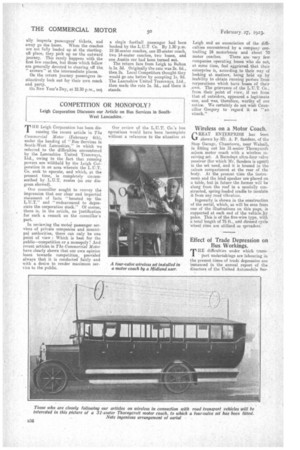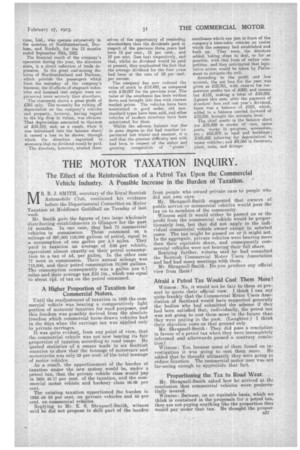COMPETITION OR MONOPOLY?
Page 20

Page 21

If you've noticed an error in this article please click here to report it so we can fix it.
Leigh Corporation Discusses our Article on Bus Services in SouthWest Lancashire..
THE Leigh Corporation has been discussing the recent article in The Commercial Motor (February 6th), under the heading of "Bus Services in South-West Lancashire," in which we referred to the difficulties encountered by the Lancashire United Tramways, Ltd., owing to the fact that running powers are withheld by the Leigh Cur. jan-ation in an area wherein the L.U.T. Co. seek to operate, and which, at the present time, is completely circumscribed by. L.U.T. routes (as our diagram showed).
One councillor sought to convey the impression that our clear and impartial statement of facts " boosted up the L.U.T." and "endeavoured to depreciate the corporation stock." Of course, there is, in the article, no justification for such a remark on the councillor's part.
In reviewing the motoi: passenger services of private companies and municipal authorities, there can only be one point of view : Which is best for the public—competition or a monopoly! And recent articles in The Commercial Motor have clearly shown thatour own opinion leans towards competition, provided always that it is conducted fairly and with a desks to render maximum service to the public.
Our review of the L.U.T. Co.'s bus operations would have been incomplete without a reference to the situation at
Leigh and an enunciation of the difficulties encountered by a company controlling 24 motorbuses and about. 70
motor coaches. There are very few companies operating buses who do not, at some time, feel aggrieved that their enterprise is, according to their way of looking at matters, being held up by inability to obtain running powers from corporations which have buses of their .own. The grievance of the L.U.T. Co., from their point of view, if not from that of outsiders, appeared a legitimate one, and was, therefore, worthy of our notice. We certainly do not wish Councillor Gregory to regard it as "sit sttack."
Wireless on a Motor Coach.
GREAT ENTERPRISE has been shown by. Mr. A. P. Sanders, of the Stop Garage, Chaaetown, near Walsall, in fitting out his 31-seater Thornycroft saloon motor coach with a wireless receiving set. A Biumdept, ultra-four valve receiver (for which Mr. Sanders is agent) is the set used, and it is housed in the saloon compartment at the rear of i he body_ At the present. time the instrument and the loud speaker are placed on a table, but in future the former will be slung from the roof in a specially constructed, spring-loaded cradle to insulate it from any road vibration.
Ingenuity is shown in the constrnction of the aerial, which, as will be seen from one of the illustrations on this page, is supported at each end of the vehicle _by poles. This is of the five-wire type, with a total length of 75 ft., and disused cycle wheel rims are utilized as spreaders.
Effect of Trade Depression on Bus Workings.
rir HE difficulties under which trans' port undertakings are labouring in the present times of trade depression are inatanced in the annual report of the directors of the United Automobile Ser vices, Ltd., who operate extensively in the counties of Northumberland, Durham, and Norfolk, for the 12 months ended September 30th, 1922. The financial result of the company's operation during the year, the directors state, is a direct reflection of trade depression. In the great coal-mining districts of Northumberland and Durham, which provide the passengers which form the mainstay of the company's business, the ill-effects of stagnant industries and lessened coal output were experienced more severely than elsewhere.
The statement shows a gross profit of £381 only. The necessity for writing off depreciation on the company's vehicles and property, however, having regard to the big drop in values, was obvious. That depreciation amounted to thetsum of £24,219, and, as a result, when it was introdnced into the balance sheet,' it caused a loss to be shown, through which the directors regretted to announce that no dividend would be paid. The directors, however, availed them.
selves of the opportunity of reminding shareholders that the dividends paid in respect of the previous three years had been 15 per cent., 15 per cent., and 10 per cent. (lees tax) respectively, and that, whilst no dividend would be paid at present, they emphasized the fact that the average dividend for the four years had been at the rate of 10 per cent. per annum.
The company has now reduced the value of stock to £19,480, as compared with £39,057 for the previous year. The value of the omnibuses has been written down and brought into line with current market prices. The vehicles have been maintained in good order, old nonstandard types have been sold, and other vehicles of modern structure have been substitnted for them.
Whilst, the adverse balance was due in some degree to the bad weather!experienced last winter and summer, it is said that the greatest difficulty met with had been in respect of the unfair and growing competition of "pirate"
omnibuses which ran just in front of the company's time-table vehicles on routes which the company had established and built up. They were, the directors added, taking steps to deal, so far as possible, with this form of unfair competition, and they anticipated that legislative action would be taken by Parliament to mitigate the evil. According to the profit and loss account, the net loss for the year was given as £23,761, with reserve for corporation profits tax of £200, and income tax £132, making a total of £24,095. Against this sum, after the payment of directors' fees and last, year's dividend, there was a balance of £255, which, added to a balance carried forward of £25,838, brought the accounts level.
The chief assets in the balance sheet are £19,480 in stooks of ' cars, spare parts, works in 'progress, accessories, etc. ; £63,872 in land and buildings; £105,085 (allowing for depreciation) in 'motor vehicles ; and £9,566 in furniture, plant, tools, and fittings.




























